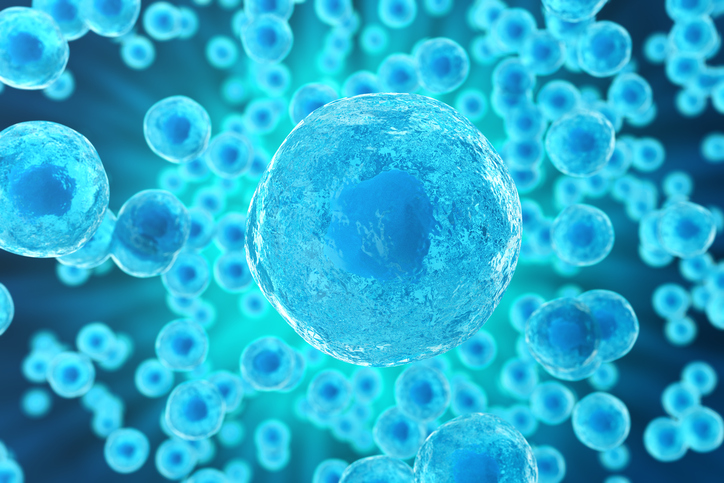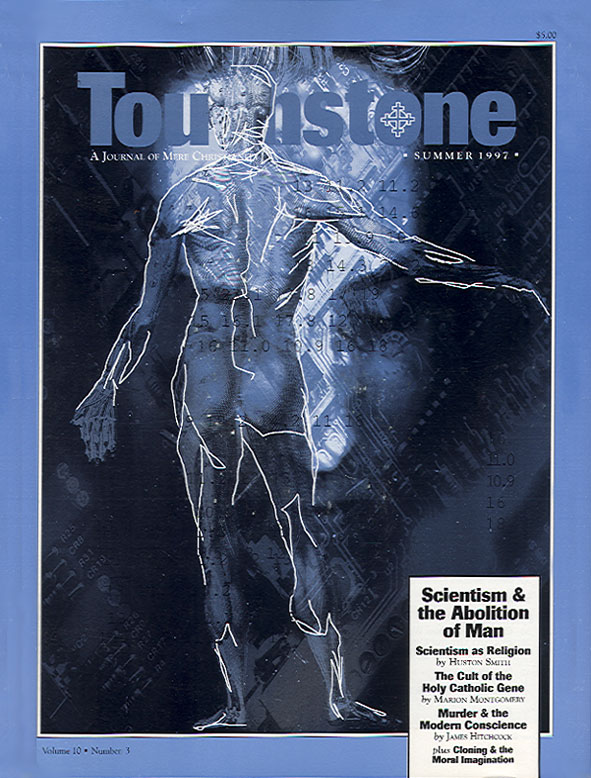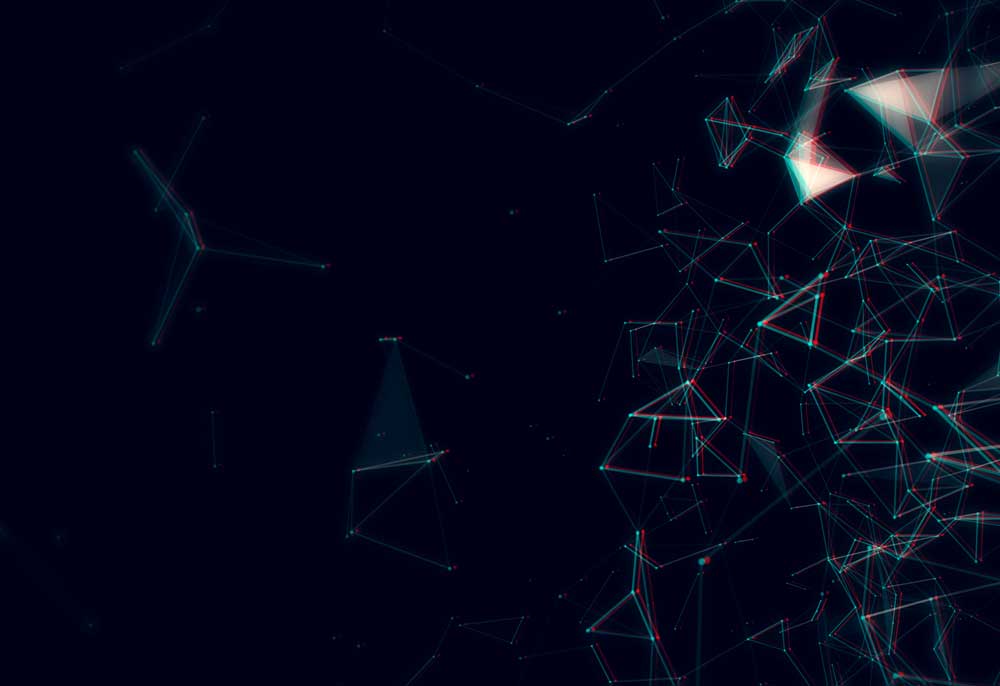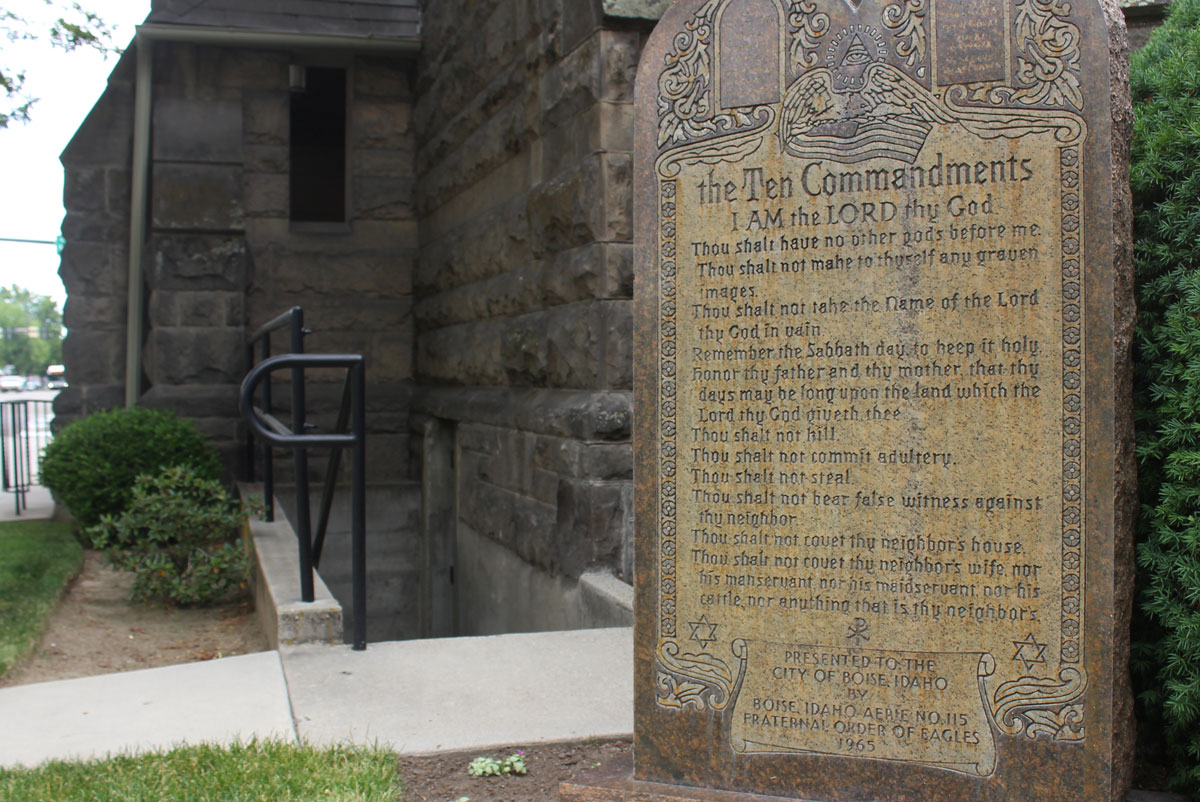The Cult of the Holy Catholic Gene
The Human Genome & the New Religion of the Scientific Social Engineer
by Marion Montgomery
A freedom which claims to be absolute ends up treating the human body as a raw datum, devoid of any meaning and moral values until freedom has shaped it in accordance with its design. Consequently, human nature and the body appear as presuppositions or preambles, materially necessary, for freedom to make its choice, yet extrinisic to the person, the subject and the human act. . . . In this way of thinking, the tension between freedom and a nature conceived of in a reductive way is resolved by a division within man himself.
—John Paul II, The Splendor of Truth
In Walker Percy’s last novel, Thanatos Syndrome, Dr. Thomas More is home on parole from the state prison where he was sent for misdeeds dramatized in Percy’s earlier novel, Love in the Ruins. Our first encounter with More is in that novel, whose subtitle is: “The Adventures of a Bad Catholic at a Time Near the End of the World.” That we are nearer that end is part of the drama of Thanatos Syndrome.
Dr. More’s remarkable adventures in Louisiana’s Feliciana Parish are well known. In his beginning as protagonist, More is the scientist as engineer. His concern is with the relation of the human psyche to biological mechanisms, the adjustments of which cause the psyche to purr contentedly—though in Love in the Ruins there is a descent of chaos instead. Now home from prison, cautious in his old familiar environment, Dr. More makes, gradually, the discovery of a sinister plot to restructure the vulnerable members of his parish by scientific engineers who are drugging the water supply. The consequences upon those citizens are bizarre, allowing Percy the range of his comic gifts in dealing with the human condition.
For “The Common Good”
What Dr. More uncovers in Feliciana Parish, setting him on a violently comic judgment delivered upon his colleagues, is a scientific program underway to reconstitute humanity itself, a program rationalized as for the common good.
Percy was disturbed by the abuse of persons by scientific engineers with social blueprints, disguised as philosophers and secular theologians. It is an arrogance of intellect in such quarters that also disturbs Professor R. C. Lewontin, who is himself a geneticist holding a prestigious chair at Harvard University. In opening his 1990 Massey Lectures, collected under the title Biology as Ideology, he observes that any “simple and dramatic theory that explains everything makes a good press.” This makes available to the theorist a purchase in the public spirit to execute theory as science for the supposed common good. For the public is “conditioned” to an amenable acceptance of any simple explanation of “everything.” What Professor Lewontin would alert us to is our easy acceptance of the mystery of the gene as both simple and dramatic and an explanation of everything.
The serious metaphysician, appreciating that existence is anything but simple, may turn again and again to the poet. But the public prefers to turn to the scientist instead of either the metaphysician or poet, its questions laid to rest by the simplifications managed through the popular media.
The Gene as Modern Grace
Professor Lewontin’s opening lecture is a call to a “Reasonable Skepticism” about the claims of the geneticists. No scientist begins life as a scientist; he is immersed in the spirit of the age from his infancy. In our age, that means a spirit characterized by some skeptics as modernism, or, in Eric Voegelin’s term, secular humanism. That spirit, characterized by the scientist Lewontin as “modern science,” “sees the world, both living and dead, as a large complicated system of gears and levers.” Out of that article of faith, “the ideology of modern science, including modern biology, makes the atom or individual the casual source of all the properties of larger collections. . . . Living beings are seen as being determined by . . . the genes.” From that ideological perspective one must conclude that “our genes . . . are propagating themselves through us.” Thus one of Professor Lewontin’s professional colleagues declares that we are “lumbering robots” whose genes “created us body and mind.”
This line of argument, summarized somewhat caustically by Professor Lewontin, goes thus: “Genes make individuals, individuals have particular preferences and behaviors, the collection or preferences and behaviors makes a culture, and so genes make culture.” In this new religion of science, “Living beings are seen as being determined by internal factors, the genes,” so that “our genes and the DNA molecules that make them up are the modern form of grace.”
Not the devil, but our genes makes us do whatever it is that we suddenly feel apologetic about—without our being able to explain why, if the geneticist’s be a true doctrine, we should feel the necessity of apology at all. Still, even if a historical “conditioned response,” the question rises about the first entry of the sense of guilt into this mechanism of oneself as an individual. Why should there continue the inclination to confession, contrition, amendment? Is the gene saving itself?
The Gene & Absolute Power
This characterization of the current state of genetic science as a religion and philosophy of human biology, incisively dramatized by Walker Percy, has proved prelude to a crucial battle now underway within the scientific and political arena which genetic faith hardly enlightens. The concern is with whether or not the genetic scientist or his patron (whether private or governmental) should be allowed to “patent” his discoveries about our biological nature, discoveries in the secret life of the gene.
At issue is a concern for the limits of research and the laws of commercial rights in relation to that research. The limits of concern have to do, not with any moral dimension of the problem such as is Percy’s concern, but with the handicap under which a given scientist may have to labor if patents exist in someone else’s name. The freedom to discover, on the one hand, the secrets of the gene as the creator of living persons and, on the other hand, the commercial profits available to the discoverers: these concerns are shallow before the mystery of life itself.
It is not science itself at issue here. Let us be quite clear on that point. For the disciplined way of seeing things, developed with such labor since Aristotle, is one of the happy gifts to intellect gained at much cost to intellect and spirit. What is awry is an arrogance of intellect whereby the truths of science are assumed to be the full explanation of existence. To possess those truths is the way to absolute power over existence itself.
Thus a willfulness of intellect would command the limited gifts of intellect, would develop a science of knowing about things, but only at the physical and biological levels as the reductionist arena of all knowing. To simplify an explanation of “everything” thereby is to control the gears and levers manipulating all things. We, as an innocent Dorothy, dawn slowly to the charade, glimpsing the wizard manipulating the machinery as less than wise, though ever so clever.
We have, after all, had considerable experience in this century with the attempts to reduce science itself to an enslavement to gnostic power—from the farce of Soviet agriculture to the tragedies of man manipulated to superhero. The actual effects come nearer and nearer, in a phrase from C. S. Lewis, to the abolition of man.
Meanwhile, mankind—in its popular spirit of consent—continues enamored. With respect to the role of genetics here, we are promised a pot of gold, if we continue fascinated by the rainbow. The pot of gold close at hand is being fought over in the concern for patents received in the human genome. It is to that struggle we now turn, carrying with us things said by Walker Percy and Professor Lewontin.
The Ideal & Infinite Gene
Bernice Wuethrich in Science News (September 4, 1993) provides a comprehensive summary of the legal chaos regarding current genetic research. What is at issue is who shall control the research and the commercial rights available increasingly as “gene therapy,” those plant-derived drugs, and certain “genetically engineered organisms.” (My emphasis) The contention is among several states (France, England, Japan, and the United States, principally) and private enterprise, the one or the other supported by public or private money, by public or private scientists.
Our central, arresting concern should be with the ambiguities involved in such a term as genetically engineered organisms. Each is a living biological creature, though it is modified from its nature. Its modification proceeds necessarily from its origins, its ground in vegetable or animal or human donor. What is said to make it unique is its isolation as an island from its being a part of the main type of its specific nature in a discrete creature. By that subterfuge we gloss over its origin as a part of vegetable or animal or man.
The manipulated creature is by that modification directed to supposed ideal ends, destined for the common good. The announcement of such ends, however, does not determine the actual ends. The idealistically conceived ends may be therapeutic in respect to human genes, or in respect to vegetable or animal genes, for better radishes or beef cows. Ideal ends only partially determine what is or may be happening in the realm of biology. For it is impossible to establish—to determine—the limit to which a mechanical power over a gene shall come. Whatever the idealistic intent of any particular scientist and his god-like assistant, the computer, finite intellect cannot comprehend ends absolutely.
The “Catholic” Gene & the Person
The ground being fought over most fiercely regarding patents is the “human genome.” We know of this creature: “Every cell in the human body has a complete set of human genes. But each type of cell expresses only a handful of the total—those it needs to perform its biological role.” That is to say that each cell bears in it, as a combination of its actuality and potentiality, a full human being. The limited actuality of a particular cell thus partakes of the humanity of a person at the level of biology, though that cell’s limited “calling” is to perform a limited function in a concert whose fullness is this particular, discrete human person.
The cell’s “calling,” its limit to a function in a larger unity, is a limit to its full participation as at once itself and as a part of a larger self, so to speak. In that participation it is member, collectively, one of another—indeed of billions of others—constituting by such ordinate membership that mysterious presence, a human being.
At another level of this mystery, it is said that a person completely replaces all cells in a span of seven years. The person meanwhile continues, as his memory tells him, even though his body of cells has been entirely replaced. One remembers at seven being an infant, at twenty-one being a small child and adolescent, and so on, though his cellular biology contains naught material of that earlier state or states of his biological being.
Here lie mysteries revealed by genetic science, which that science seems indifferent to, if noticed at all: the mystery of a unity subsuming the separate discrete cells by a harmony and a continuity—a continuing body of a continuing person whose name represents a complexity beyond the limits of biology itself. St. Paul perhaps would find genetic science supporting that moving metaphor of his: our body’s discrete “members” (head, foot, hand) constituting a unity of our person proportionately—according to the “callings” of those disparate members—like that whole person as member of a larger body whose “head” is Christ.
That intense scientist of being, St. Thomas Aquinas, no doubt would find more than metaphor involved in this description of the “human genome,” with the discrete cell bearing “all” actually and potentially, while called by its actual to a limited role in affecting that “all”—the existing actual discrete person.
Indeed, St. Thomas might well see genetics as supporting his understanding—arrived at haltingly in part by the somewhat primitive biology available to him—of that mysterious unity of person he speaks of, the soul as an “essential unity,” the “substantial form” of the body. He might feel further supported out of other sciences as well, sciences discrete from biology of the human which seek a unified theory of being, as in physics’ hunger for a unified theory since Einstein. Or there is that fascinating mystery in botany, whereby there seems to be a “soul” operative in a plant, as if it were moved by a desire for unity of being as its natural teleology. To break off a growing tip of an oak just burgeoning is to effect a redistribution of ends within discrete cells, so that what appears first as a lateral branch turns upward and becomes the growing tip, sending out its own lateral branches.
Our Souls & the Industrialization of the Body
The “soul” as the substantial form of a body is a metaphysical perspective upon physics and biology not yet cast irretrievably into the dustbin of ideas, though arrogant will has struggled to do so these past five or six hundred years. How common to denigrate the “dark ages,” when even plants were thought to possess “souls,” though not like man’s. In that childhood of our understanding, we were possessed by fantasy, believing even in dragons.
But it is no accident that the pretenses of willful intellect, through its gnostic dissociation from reality in our own day and through the remarkable technology (in part accomplished through that dissociation) provides the popular spirit with a new entertainment more seductive than Beowulf—“virtual reality.” It is a reality distinct from actual reality, whereby one may simulate the experiences of reality while safely removed from it. Such entertainment becomes for our century, one hazards, a substitute for the less vivid species of virtual reality provided by the Marquis de Sade. George Steiner remarked, “It is in Sade . . . that we find the first methodical industrialization of the human body.”
And so we turn to that industrialization as centered today in the “human genome,” the dimension of our biological being determined by DNA. The cell with its peculiar role becomes for that science a happy hunting ground for capturing a control of that peculiar role, in the name of the therapeutic end. Here lies the possibility of controlling all manner of ills that flesh and bone are heir to, from pimples to cancer.
Man as Nothing More than Profit & Property
Little wonder, then, that there is underway a new gold rush, with the human genome the territory for exploration in which to stake claim. In the aforementioned account in Science News of the struggle to gain access to a cell’s discrete biological role, our reporter, Bernice Wuethrich, speaks of the moral dimension twice, and only in passing, as when she says simply that the French government, which funds most of the genetic research in France, “opposes patenting gene fragments on both moral and practical grounds.” In the article’s context, it is apparent that the moral grounds have to do with whether the state or the private sector shall determine research uses of the human genome and the commercial deployment of the research results. What shall be made of gene fragments, by whom?
As for this new Oklahoma Territory of the human genome, in relation to the endless “gene fragments” within it: that genome is “nothing more than a varying series of four simple chemical units, called nucleotide bases. Billions of these bases link together to form molecules of DNA,” the genetic power resting in those bases as used in a special way by the discrete cell. Their linear sequence along the DNA molecule defines a gene, so that by defining a segment of the sequence (a gene fragment) one anticipates the gene itself.
But what a chilling way to put the mystery of the cell: it is “nothing more” than variations of “four simple chemical units.” (All existence is nothing more than variations on four simple elements: earth, water, air, fire.) Thus reduced to the material as limited by the spatial and temporal, life becomes nothing more than chemical manipulations. Such is the ground to our understanding of life where the war is waged over whether or not components of life may be patented and thus “owned,” the human reduced to chemical genome property.
Copyrighted Man & Nominalism
In this war, whoever names the gene fragment defines a section of the sequence (a gene fragment) and thereby accesses “the protein for which the [whole] gene codes.” To command that protein by naming the sequence fragment is to control the whole gene by that knowledge, though the whole gene itself may not be known. In that power rests the economic and social value of this partial conquest of a territory containing “billions” of gene fragments, base links, within a molecule of DNA. And the moral concern in this debate is over who shall hold the patent to the name and description of the thing, this linear fragment.
But one might venture that perhaps the question is one of copyright rather than patent. The prize contended for is legal authority over the genome itself—but through nominalism. By the power allowed through control of the name, both the thing and its uses will be determined. Both political and economic control resides thus in what Eric Voegelin might call nominalism as the ultimate instrument of gnosis, a control divorced from the complex reality of the thing by the device of a restrictive naming. It is inescapable that biological existence is at issue. Less well recognized, so too is spiritual existence.
In anticipation of gaining power through patent, the race is joined, one aspect of which is not without considerable irony. Consider: a private conglomerate made up of TIGR (tiger) and Human Genome Sciences “operates a virtual biogenetic factory, with dozens of sequencing robots around the clock.” The director of this enterprise reports: “We are now finding several hundred ESTs per day, and we’re not yet at full scale.” EST is “expressed sequence tag,” the “name” of the gene fragment, which points to the complete gene. The right to patent ESTs justifies patenting the gene pointed to, thus reserving the as yet unexplored territory to the initial prospector and his trusty companion and scout, the computer robot.
The fierceness of the contention over this issue of patenting the whole gene is sufficient to alert us to dark troubles to come when the power of law is settled upon the shoulders of science, whether public or private science. As usual, we shall be asked to consent on the grounds that the general good is at issue.
Moral Philosophers Sidelined
Who shall control the research and the commercial fruits of that research; by what laws and agencies? It is not that such questions are not important, nor that they are not proper questions in the interest of the general well-being, if set proportionately to larger questions.
What is disturbing is that these questions are joined as if at an ultimate moral level in respect to the rights of research and profits from research in human nature itself, with state, institutional, and personal rights in the balance at the least.
We know all too well that human laws, including patent laws, never establish limits that cannot be subsequently modified by yet another human law. Nor does human law depend effectively on a common will unfailingly attuned to the common good—that old dream of society as a unified utopia. (The dreaming idealist supposes his own dream in a vision of the essential unity of humanity.)
In this century most particularly the “law” depends upon who holds the instruments of power: that is, copyrights and patents formalized as the mechanisms to control. Stalin, we remember, responded to a pope’s moral objection to perversion of persons with the question, “How many battalions has the pope?”
To our general confusion, the climate of this debate has its participants publicly subscribing to an idealistic assumption: medical genetics, as Marc Pearson, president of Darwin Molecular Technologies, says, has the potential to “define the molecular basis of disease [and] identify all targets for all therapeutics for all time.”
With that high humanitarian concern as a public justification, government agencies—from patent office to congressional committees—hold hearings to settle the “moral” question of whether the state (in the name of the public good) or the private sector (in the name of efficiency through competition in the name of the public good) shall have control of the naming of the fragments of the human genome. But to those hearings, by all accounts, only scientists in the fields of genetics are summoned, on the assumption that their specialized knowledge of the names of the gene fragments is the acceptable qualification in determining what is the public good. No moral philosopher need apply.
Merchants of Evil for the Public Good
In the name of the public good, let us assert that the issue lies in an arena larger than the reductionist view of the gene fragment per se, an arena larger even than Marc Pearson’s dream of delivering mankind from bodily ills “for all time.”
First, who shall define disease or ill, in relation to the mystery of the whole person, that person whom common sense reveals to us as larger than the sum of the gene fragments reserved to that most singular person? It is not an unjustified scare tactic that makes us recall that a few years ago a captain of genetic power as utopian ideal, Adolph Hitler, would have welcomed our latest knowledge of genetics. He would have dreamed his super race could be produced more rapidly than antiquated, old-fashioned, breeding schedules could effect.
An even more disturbing, if less conspicuous danger than a Hitler—dangerous precisely because inconspicuous—are the ideologists who so frightened Walker Percy, those doctors of the Weimar Republic who advocated abortion and euthanasia as the most tender of concerns for the public welfare, thus preparing the conditions of thought in the public spirit for the advent of Hitler.
Percy finds descendants of those high-minded merchants of death among us. That he does so makes him almost as unwelcome in some quarters as Solzhenitsyn found himself at Harvard when he spoke of the same climate of thought as pervasive of Western intellectual society as that found then in the U. S. S. R.
A Triumph Only in Fiction
Percy dramatizes an analogous version of this current misappropriation of the human genome in the name of the common good, in his Thanatos Syndrome. Dr. Tom More wakes gradually to a point of violent reaction, wakes out of his own Weimar Republic’s syndrome, to discover his scientific colleagues, the gnostic intelligentsia, as ravenous for a willful power over persons. They would, by that willful exercise of power over other persons and through manipulations of persons by plant and chemically derived drugs, establish a program in the name of the public good but which would effectively erase persons through reduction of humanity to mechanisms—that is, to be practiced upon by the manipulators themselves. Dr. More turns the tables on them with violently comic effect in the novel’s concluding chapters.
Man as biological robot: that is the religion of the scientific sociological engineer whom Percy indicts. But he does so in fictions. Meanwhile, those very engineers dominate in the corridors of economic and political power at this moment. And so we seem even nearer the “end of the world” than when Dr. Tom More is first encountered by us in Love in the Ruins.
Marion Montgomery has published books of poetry, fiction, and criticism. His books include the trilogy, The Prophetic Poet and the Spirit of the Age, and most recently Romantic Confusions of the Good: Beauty as Truth, Truth Beauty. A collection of essays on higher education is due out from Spence Publishing Company in 1998. He lives in Crawford, Georgia.
subscription options
Order
Print/Online Subscription

Get six issues (one year) of Touchstone PLUS full online access including pdf downloads for only $39.95. That's only $3.34 per month!
Order
Online Only
Subscription

Get a one-year full-access subscription to the Touchstone online archives for only $19.95. That's only $1.66 per month!
bulk subscriptions
Order Touchstone subscriptions in bulk and save $10 per sub! Each subscription includes 6 issues of Touchstone plus full online access to touchstonemag.com—including archives, videos, and pdf downloads of recent issues for only $29.95 each! Great for churches or study groups.
Transactions will be processed on a secure server.
more on science from the online archives
more from the online archives
calling all readers
Please Donate
"There are magazines worth reading but few worth saving . . . Touchstone is just such a magazine."
—Alice von Hildebrand
"Here we do not concede one square millimeter of territory to falsehood, folly, contemporary sentimentality, or fashion. We speak the truth, and let God be our judge. . . . Touchstone is the one committedly Christian conservative journal."
—Anthony Esolen, Touchstone senior editor













